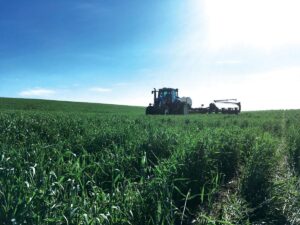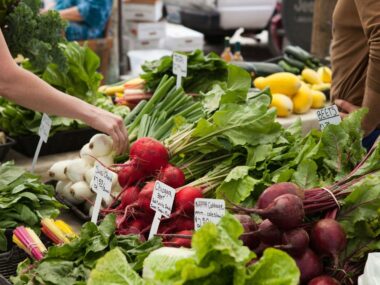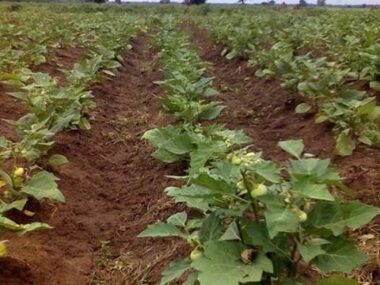Introduction
Precision agriculture (PA) is a farming management concept that uses information technology (IT) and various high-tech systems to ensure that crops and soil receive exactly what they need for optimum health and productivity. This method aims to ensure profitability, sustainability, and environmental protection. This note examines the role of precision agriculture in modern farming, highlighting its techniques, benefits, challenges, and future potential.

Key Techniques in Precision Agriculture
- Global Positioning System (GPS) Technology
- Description: GPS technology is used to map fields and track the exact location of farm machinery. It provides real-time data on the position of equipment and crops.
- Application: Farmers can apply inputs like fertilizers, pesticides, and water with pinpoint accuracy, reducing waste and improving efficiency.
- Remote Sensing
- Description: Remote sensing involves the use of satellite or drone imagery to monitor crop health, soil conditions, and field variability.
- Application: Farmers can detect issues like pest infestations, nutrient deficiencies, and water stress early, allowing for timely intervention.
- Variable Rate Technology (VRT)
- Description: VRT allows the application rate of inputs (seeds, fertilizers, pesticides) to be varied across a field based on precise data.
- Application: Optimizes input use, improves crop yields, and reduces environmental impact by applying the right amount of inputs where they are needed most.
- Yield Monitoring and Mapping
- Description: Combines data from GPS and yield sensors to create detailed maps of crop yields across different parts of a field.
- Application: Helps farmers understand yield variability and make informed decisions about planting, fertilization, and irrigation.
- Soil Sampling and Mapping
- Description: Involves taking soil samples from different parts of a field and analyzing them for nutrient levels, pH, and organic matter content.
- Application: Enables targeted soil management practices to enhance soil health and productivity.
- Internet of Things (IoT)
- Description: IoT devices, such as sensors and smart meters, collect and transmit data on various farming parameters.
- Application: Allows for real-time monitoring and management of farm operations, improving efficiency and reducing labor costs.
Benefits of Precision Agriculture
- Increased Productivity
- By applying inputs more precisely and efficiently, farmers can achieve higher crop yields and better-quality produce. Precision agriculture helps optimize the growth conditions for crops, leading to improved productivity.
- Cost Savings
- Precision agriculture reduces the over-application of inputs, leading to significant cost savings. Farmers spend less on fertilizers, pesticides, and water, thus lowering overall production costs.
- Environmental Protection
- By minimizing the use of chemicals and water, precision agriculture reduces the environmental footprint of farming. It helps prevent soil degradation, water contamination, and loss of biodiversity.
- Improved Decision Making
- Access to accurate and timely data allows farmers to make informed decisions about their farming practices. This leads to better resource management, enhanced crop management, and ultimately higher profitability.
- Sustainability
- Precision agriculture promotes sustainable farming practices by ensuring that resources are used efficiently and responsibly. This contributes to long-term farm viability and resilience.
Challenges of Precision Agriculture
- High Initial Costs
- The technology and equipment required for precision agriculture can be expensive. This high initial investment can be a barrier for small and medium-sized farms.
- Technical Complexity
- Precision agriculture requires a certain level of technical knowledge and expertise. Farmers may need training and support to effectively use and maintain precision farming tools.
- Data Management
- The vast amount of data generated by precision agriculture systems needs to be properly managed and analyzed. This requires robust data management systems and analytical tools.
- Connectivity Issues
- Reliable internet and communication networks are essential for the operation of many precision agriculture technologies. In rural areas, connectivity issues can limit the effectiveness of these systems.
- Integration with Existing Practices
- Integrating precision agriculture technologies with traditional farming practices can be challenging. Farmers may need to adapt their current practices to fully benefit from precision agriculture.
Future Potential of Precision Agriculture
- Advancements in AI and Machine Learning
- The integration of artificial intelligence (AI) and machine learning in precision agriculture can further enhance decision-making processes. Predictive analytics can provide insights into crop growth patterns, pest outbreaks, and optimal input application.
- Automation and Robotics
- The use of autonomous machinery and robots can revolutionize precision agriculture by performing tasks such as planting, weeding, and harvesting with high precision and efficiency.
- Climate Adaptation
- Precision agriculture can play a crucial role in helping farmers adapt to climate change. By optimizing water use and improving soil health, farmers can build more resilient agricultural systems.
- Enhanced Sustainability
- Future advancements in precision agriculture can further promote sustainable farming practices, ensuring that food production can meet the growing global demand while minimizing environmental impact.
- Global Adoption
- As technology becomes more affordable and accessible, precision agriculture has the potential to be adopted on a global scale, transforming farming practices worldwide.
Conclusion
Precision agriculture represents a significant advancement in modern farming, offering numerous benefits in terms of productivity, cost savings, environmental protection, and sustainability. While there are challenges to its adoption, the potential of precision agriculture to revolutionize farming practices and contribute to a more sustainable and resilient agricultural sector is immense. By leveraging the latest technologies and continuing to innovate, precision agriculture can help meet the growing global demand for food while preserving the planet’s resources for future generations.










